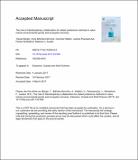Files in this item
The role of interdisciplinary collaboration for stated preference methods to value marine environmental goods and ecosystem services
Item metadata
| dc.contributor.author | Börger, Tobias | |
| dc.contributor.author | Böhnke-Henrichs, Anne | |
| dc.contributor.author | Hattam, Caroline | |
| dc.contributor.author | Piwowarczyk, Joanna | |
| dc.contributor.author | Schasfoort, Femke | |
| dc.contributor.author | Austen, Melanie C. | |
| dc.date.accessioned | 2018-03-09T00:33:12Z | |
| dc.date.available | 2018-03-09T00:33:12Z | |
| dc.date.issued | 2018-02-05 | |
| dc.identifier | 249327513 | |
| dc.identifier | a530b6fc-d630-4184-ab43-c88338faebf4 | |
| dc.identifier | 85014792804 | |
| dc.identifier | 000427210100015 | |
| dc.identifier.citation | Börger , T , Böhnke-Henrichs , A , Hattam , C , Piwowarczyk , J , Schasfoort , F & Austen , M C 2018 , ' The role of interdisciplinary collaboration for stated preference methods to value marine environmental goods and ecosystem services ' , Estuarine, Coastal and Shelf Science , vol. 201 , pp. 140-151 . https://doi.org/10.1016/j.ecss.2017.03.009 | en |
| dc.identifier.issn | 0272-7714 | |
| dc.identifier.other | RIS: urn:FF652C27B12405EE13AC527DB692CE06 | |
| dc.identifier.uri | https://hdl.handle.net/10023/12884 | |
| dc.description | This study was funded by the European Community's Seventh Framework Programme (FP7/2007–2013) within the Ocean of Tomorrow call under Grant Agreement No.266445 for the project Vectors of Change in Oceans and Seas Marine Life, Impact on Economic Sectors (VECTORS). | en |
| dc.description.abstract | With the increasing use of environmental valuation methods in coastal, marine and deep-sea settings, there is a growing need for the collaboration of natural scientists and environmental economists. Stated preference valuation methods in particular need to be based on sound natural science information and translate such information to be used in social surveys. This paper uses three applications to make explicit the flow of information between different disciplines in the preparation and implementation of stated preference studies. One approach for facilitating this flow is to increase knowledge and understanding of natural scientists on these methods. To address this, this paper highlights key opportunities and pitfalls and demonstrates those in the context of three case studies. It therefore provides guidance on stated preference valuation for natural scientists rather than for economists. | |
| dc.format.extent | 2233528 | |
| dc.language.iso | eng | |
| dc.relation.ispartof | Estuarine, Coastal and Shelf Science | en |
| dc.subject | Marine ecosystems | en |
| dc.subject | Environmental valuation | en |
| dc.subject | Stated preference methods | en |
| dc.subject | Discrete choice experiments | en |
| dc.subject | GE Environmental Sciences | en |
| dc.subject | GC Oceanography | en |
| dc.subject | QH301 Biology | en |
| dc.subject | T-NDAS | en |
| dc.subject | SDG 14 - Life Below Water | en |
| dc.subject.lcc | GE | en |
| dc.subject.lcc | GC | en |
| dc.subject.lcc | QH301 | en |
| dc.title | The role of interdisciplinary collaboration for stated preference methods to value marine environmental goods and ecosystem services | en |
| dc.type | Journal article | en |
| dc.contributor.sponsor | European Commission | en |
| dc.contributor.institution | University of St Andrews. School of Geography & Sustainable Development | en |
| dc.identifier.doi | https://doi.org/10.1016/j.ecss.2017.03.009 | |
| dc.description.status | Peer reviewed | en |
| dc.date.embargoedUntil | 2018-03-08 | |
| dc.identifier.grantnumber | 266445 | en |
This item appears in the following Collection(s)
Items in the St Andrews Research Repository are protected by copyright, with all rights reserved, unless otherwise indicated.

